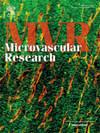Nrf2 deficiency blunts exercise training-induced adaptations of coronary resistance arteries
IF 2.7
4区 医学
Q2 PERIPHERAL VASCULAR DISEASE
引用次数: 0
Abstract
Exercise training upregulates nuclear factor erythroid 2-related factor 2 (Nrf2) expression and antioxidant production in various tissues; however, little is known about the role of Nrf2 in exercise training-induced adaptations of blood vessels. This study investigated how deletion of Nrf2 affects vasomotor function in coronary resistance arteries in sedentary and exercise-trained rats. Wild-type (WT) and Nrf2 knockout (KO) rats underwent 10 weeks of treadmill exercise or remained sedentary. Coronary resistance arteries were isolated for assessment of vasomotor responses. In resistance arteries from Nrf2 KO rats, endothelin-induced constriction was blunted, but exercise training partially restored responsiveness to endothelin; after exercise training, responses to endothelin were not different between arteries from WT and Nrf2 KO rats. Similarly, KCl-induced constriction was reduced in arteries from Nrf2 KO rats, but exercise training reversed this loss of responsiveness to KCl. Nitric oxide (NO)-mediated vasodilation of coronary resistance arteries was not altered by deletion of Nrf2; however, exercise training enhanced NO-mediated dilation in arteries from WT, but not Nrf2 KO rats. Similarly, exercise training increased vasodilation to low concentrations of potassium (10 and 20 mM KCl) in arteries from WT, but not Nrf2 KO rats. These findings suggest that Nrf2 is critical to maintenance of contractile responses in coronary resistance arteries, but exercise training can restore contractile function through Nrf2-independent mechanisms. In contrast, vasodilatory responses to NO and low-level potassium are maintained in coronary resistance arteries from Nrf2-deficient rats, but exercise training fails to enhance these vasodilatory responses in the absence of Nrf2.
Nrf2缺乏使运动训练诱导的冠状动脉阻力适应变迟钝。
运动训练上调核因子红细胞2相关因子2 (Nrf2)的表达和各组织抗氧化剂的产生;然而,Nrf2在运动训练诱导的血管适应性中的作用知之甚少。本研究探讨了Nrf2缺失如何影响久坐和运动训练大鼠冠状动脉血管舒缩功能。野生型(WT)和Nrf2敲除(KO)大鼠进行10 周的跑步机运动或保持久坐。分离冠脉阻力动脉以评估血管舒缩反应。在Nrf2 KO大鼠的阻力动脉中,内皮素诱导的收缩被减弱,但运动训练部分恢复了对内皮素的反应性;运动训练后,WT和Nrf2 KO大鼠动脉对内皮素的反应没有差异。同样,Nrf2 KO大鼠的动脉中KCl诱导的收缩减少,但运动训练逆转了这种对KCl的反应性丧失。一氧化氮(NO)介导的冠状动脉血管舒张不因Nrf2的缺失而改变;然而,运动训练增强了WT大鼠no介导的动脉扩张,而Nrf2 KO大鼠则没有。同样,运动训练增加了WT大鼠动脉中低浓度钾(10和20 mM KCl)的血管舒张,但Nrf2 KO大鼠没有。这些发现表明Nrf2对于维持冠状动脉的收缩反应至关重要,但运动训练可以通过Nrf2独立的机制恢复收缩功能。相比之下,Nrf2缺乏的大鼠冠状动脉对NO和低水平钾的血管舒张反应得以维持,但在缺乏Nrf2的情况下,运动训练不能增强这些血管舒张反应。
本文章由计算机程序翻译,如有差异,请以英文原文为准。
求助全文
约1分钟内获得全文
求助全文
来源期刊

Microvascular research
医学-外周血管病
CiteScore
6.00
自引率
3.20%
发文量
158
审稿时长
43 days
期刊介绍:
Microvascular Research is dedicated to the dissemination of fundamental information related to the microvascular field. Full-length articles presenting the results of original research and brief communications are featured.
Research Areas include:
• Angiogenesis
• Biochemistry
• Bioengineering
• Biomathematics
• Biophysics
• Cancer
• Circulatory homeostasis
• Comparative physiology
• Drug delivery
• Neuropharmacology
• Microvascular pathology
• Rheology
• Tissue Engineering.
 求助内容:
求助内容: 应助结果提醒方式:
应助结果提醒方式:


